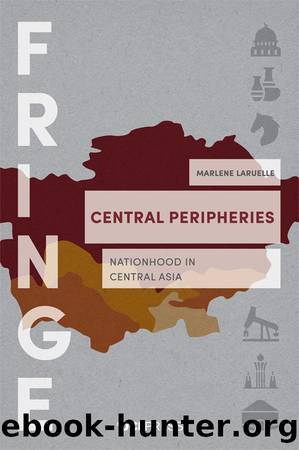Central Peripheries by Marlene Laruelle

Author:Marlene Laruelle
Language: eng
Format: epub
ISBN: 9781800080164
Publisher: UCL Press
Published: 2021-06-19T17:43:43+00:00
Eurasianism as Kazakhstanâs state ideology
Far from being merely a Kazakh literary tradition elaborated during Soviet times, Eurasianism has been officialized as Kazakhstanâs state ideology, functioning, as Luca Anceschi puts it, in âquasi-symbiotic relationship [with] authoritarianismâ.10 Immediately after independence, in the first half of the 1990s, Kazakhstan began branding itself as âthe heart of Eurasiaâ. As Nazarbayev declared: âKazakhstan is a unique state in Asia where European and Asian roots are intertwined ⦠The combination of different cultures and traditions allows us to absorb what is best in European and in Asian cultureâ.11 This geographical centrality in Eurasia is captured by a sculpture in Zhastar Ayabagy Park in Astana through the explicit metaphor of a heart whose central red point suggests Kazakhstan.12
To compete with Uzbek President Islam Karimov, who advanced the notion of Turkestan, Nazarbayev referred to Eurasia in many of his texts. His 2005 book In the Heart of Eurasia (V serdtse Evrazii) encapsulates this Eurasianist commitment. He institutionalized this allegiance to Eurasianism by founding, in 1996, the Lev N. Gumilev Eurasian University in Astana on the foundations of the cityâs former pedagogical institute. During the celebrations of ten years of independence held at the university in 2001, the famous Kyrgyz writer Chingiz Aitmatov spoke favourably about Kazakhstanâs Eurasianism and the decision to name the University after Gumilev, which he called a confirmation of Kazakhstanâs status as the epicentre of Eurasia.13
Nazarbayev gave his personal blessing to this official reference to Gumilev: just as in Tatarstan, the Kazakhstani authorities subscribe to a positive view of Gumilevâs legacy, both in Eurasian history and ethnic theories. Since then, the university has regularly organized conferences on Eurasianism as well as lectures on Gumilevâs work. It even launched its own Eurasian Centre, which was charged âto define a conception of Eurasianism that would respond to Kazakhstanâs national interests; to develop a geopolitical methodology for the historical, socio-economic, and ideological interpretation of the development of contemporary civilization; and to advise state, educational, and academic organizations on Eurasianismâ.14 One of its former directors, Seit Kaskabasov, buttressed the presidentâs vision of Kazakhstanâs Eurasian mission with more elaborate historical arguments. He stated, for instance, that there exist three Eurasian states â Russia and Kazakhstan (both heirs to the Mongol Empire), and Turkey (with its Byzantine and Ottoman heritage) â that must jointly constitute a new trans-Eurasian axis. According to this logic, Kazakhstan holds the status of first among equals, as it finds itself geographically located between the other two powers.15
This state-backed Eurasianism results from the regimeâs need for securitization. At its independence, Kazakhstan had to deal with a massive Russian minority and the risk that northern regions might secede. A pragmatic way of ensuring stability was thus to promote the birth of a civic and supra-ethnic Kazakhstani identity, to offer an official status to the Russian language and to insist on Russia as the countryâs main partner. At the same time, Nazarbayev could not afford to lose his political clout to Kazakhstanâs nationalist opposition: he had to appear to be defending the Kazakh nation.
Download
This site does not store any files on its server. We only index and link to content provided by other sites. Please contact the content providers to delete copyright contents if any and email us, we'll remove relevant links or contents immediately.
| Accounting | Economics |
| Exports & Imports | Foreign Exchange |
| Global Marketing | Globalization |
| Islamic Banking & Finance |
The Meaning of the Library by unknow(2503)
Six Billion Shoppers by Porter Erisman(2266)
Why Nations Fail: The Origins of Power, Prosperity, and Poverty by Daron Acemoglu & James Robinson(2234)
No Time to Say Goodbye(2054)
Red Notice by Bill Browder(2024)
The Economist [T6, 22 Thg9 2017] by The Economist(1890)
Currency Trading For Dummies by Brian Dolan(1878)
Thank You for Being Late by Thomas L. Friedman(1738)
Bitcoin: The Ultimate Guide to the World of Bitcoin, Bitcoin Mining, Bitcoin Investing, Blockchain Technology, Cryptocurrency (2nd Edition) by Ikuya Takashima(1664)
Amazon FBA: Amazon FBA Blackbook: Everything You Need To Know to Start Your Amazon Business Empire (Amazon Empire, FBA Mastery) by John Fisher(1540)
Coffee: From Bean to Barista by Robert W. Thurston(1486)
The Future Is Asian by Parag Khanna(1436)
The Great Economists by Linda Yueh(1432)
How Money Got Free: Bitcoin and the Fight for the Future of Finance by Brian Patrick Eha(1384)
Grave New World by Stephen D. King(1383)
Pocket World in Figures 2018 by The Economist(1375)
Capitalism Without Capital: The Rise of the Intangible Economy by Jonathan Haskel(1373)
The Sex Business by Economist(1344)
Cultural Intelligence by David C. Thomas(1261)
